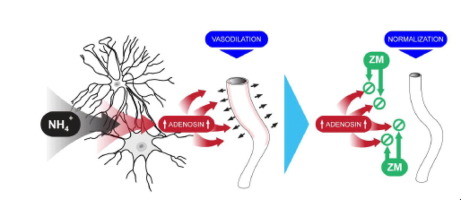当前位置:
X-MOL 学术
›
J. Hepatol.
›
论文详情
Our official English website, www.x-mol.net, welcomes your feedback! (Note: you will need to create a separate account there.)
Impaired cerebral microcirculation induced by ammonium chloride in rats is due to cortical adenosine release
Journal of Hepatology ( IF 25.7 ) Pub Date : 2018-06-01 , DOI: 10.1016/j.jhep.2018.01.034 Peter Nissen Bjerring , Esben Jannik Bjerrum , Fin Stolze Larsen
Journal of Hepatology ( IF 25.7 ) Pub Date : 2018-06-01 , DOI: 10.1016/j.jhep.2018.01.034 Peter Nissen Bjerring , Esben Jannik Bjerrum , Fin Stolze Larsen

|
BACKGROUND & AIMS
Liver failure results in hyperammonaemia, impaired regulation of cerebral microcirculation, encephalopathy, and death. However, the key mediator that alters cerebral microcirculation remains unidentified. In this study we show that topically applied ammonium significantly increases periarteriolar adenosine tone on the brain surface of healthy rats and is associated with a disturbed microcirculation. METHODS
Cranial windows were prepared in anaesthetized Wistar rats. The flow velocities were measured by speckle contrast imaging and compared before and after 30 min of exposure to 10 mM ammonium chloride applied on the brain surface. These flow velocities were compared with those for control groups exposed to artificial cerebrospinal fluid or ammonium plus an adenosine receptor antagonist. A flow preservation curve was obtained by analysis of flow responses to a haemorrhagic hypotensive challenge and during stepwise exsanguination. The periarteriolar adenosine concentration was measured with enzymatic biosensors inserted in the cortex. RESULTS
After ammonium exposure the arteriolar flow velocity increased by a median (interquartile range) of 21.7% (23.4%) vs. 7.2% (10.2%) in controls (n = 10 and n = 6, respectively, p <0.05), and the arteriolar surface area increased. There was a profound rise in the periarteriolar adenosine concentration. During the hypotensive challenge the flow decreased by 27.8% (14.9%) vs. 9.2% (14.9%) in controls (p <0.05). The lower limit of flow preservation remained unaffected, 27.7 (3.9) mmHg vs. 27.6 (6.4) mmHg, whereas the autoregulatory index increased, 0.29 (0.33) flow units per millimetre of mercury vs. 0.03 (0.21) flow units per millimetre of mercury (p <0.05). When ammonium exposure was combined with topical application of an adenosine receptor antagonist, the autoregulatory index was normalized. CONCLUSIONS
Vasodilation of the cerebral microcirculation during exposure to ammonium chloride is associated with an increase in the adenosine tone. Application of a specific adenosine receptor antagonist restores the regulation of the microcirculation. This indicates that adenosine could be a key mediator of the brain dysfunction seen during hyperammonaemia and is a potential therapeutic target. LAY SUMMARY
In patients with liver failure, disturbances in brain function are caused in part by ammonium toxicity. In our project we studied how ammonia, through adenosine release, affects the blood flow in the brain of rats. In our experimental model we demonstrated that the detrimental effect of ammonia on blood flow regulation was counteracted by blocking the adenosine receptors in the brain. With this observation we identified a novel potential treatment target. If we can confirm our findings in a future clinical study, this might help patients with liver failure and the severe condition called hepatic encephalopathy.
中文翻译:

氯化铵致大鼠脑微循环障碍是皮质腺苷释放所致
背景和目的 肝功能衰竭会导致高氨血症、脑微循环调节受损、脑病和死亡。然而,改变大脑微循环的关键介质仍未确定。在这项研究中,我们表明局部应用的铵显着增加了健康大鼠脑表面的小动脉周围腺苷浓度,并与微循环障碍有关。方法在麻醉的Wistar大鼠中制备颅窗。通过散斑对比成像测量流速,并在暴露于应用于大脑表面的 10 mM 氯化铵 30 分钟之前和之后进行比较。将这些流速与暴露于人工脑脊液或铵加腺苷受体拮抗剂的对照组的流速进行比较。通过分析对出血性低血压挑战和逐步放血期间的血流反应,获得血流保持曲线。用插入皮质的酶生物传感器测量小动脉周围腺苷浓度。结果 暴露于铵盐后,对照组(分别为 n = 10 和 n = 6,p <0.05)的小动脉流速增加了 21.7% (23.4%) 和 7.2% (10.2%) 的中位数(四分位距),并且小动脉表面积增加。小动脉周围腺苷浓度显着升高。在低血压挑战期间,流量减少了 27.8% (14.9%),而对照组为 9.2% (14.9%) (p <0.05)。流量保持的下限不受影响,分别为 27.7 (3.9) mmHg 与 27.6 (6.4) mmHg,而自动调节指数增加了 0.29 (0. 33) 每毫米汞柱的流量单位与每毫米汞柱的 0.03 (0.21) 流量单位 (p <0.05)。当铵暴露与腺苷受体拮抗剂的局部应用相结合时,自动调节指数正常化。结论 暴露于氯化铵期间脑微循环的血管舒张与腺苷张力增加有关。特定腺苷受体拮抗剂的应用可恢复微循环的调节。这表明腺苷可能是高氨血症期间出现的脑功能障碍的关键介质,并且是潜在的治疗靶点。概述 在肝功能衰竭患者中,脑功能障碍部分是由铵毒性引起的。在我们的项目中,我们研究了氨如何通过腺苷释放,影响大鼠大脑中的血流量。在我们的实验模型中,我们证明了通过阻断大脑中的腺苷受体来抵消氨对血流调节的不利影响。通过这一观察,我们确定了一个新的潜在治疗目标。如果我们能在未来的临床研究中证实我们的发现,这可能有助于肝功能衰竭和称为肝性脑病的严重疾病患者。
更新日期:2018-06-01
中文翻译:

氯化铵致大鼠脑微循环障碍是皮质腺苷释放所致
背景和目的 肝功能衰竭会导致高氨血症、脑微循环调节受损、脑病和死亡。然而,改变大脑微循环的关键介质仍未确定。在这项研究中,我们表明局部应用的铵显着增加了健康大鼠脑表面的小动脉周围腺苷浓度,并与微循环障碍有关。方法在麻醉的Wistar大鼠中制备颅窗。通过散斑对比成像测量流速,并在暴露于应用于大脑表面的 10 mM 氯化铵 30 分钟之前和之后进行比较。将这些流速与暴露于人工脑脊液或铵加腺苷受体拮抗剂的对照组的流速进行比较。通过分析对出血性低血压挑战和逐步放血期间的血流反应,获得血流保持曲线。用插入皮质的酶生物传感器测量小动脉周围腺苷浓度。结果 暴露于铵盐后,对照组(分别为 n = 10 和 n = 6,p <0.05)的小动脉流速增加了 21.7% (23.4%) 和 7.2% (10.2%) 的中位数(四分位距),并且小动脉表面积增加。小动脉周围腺苷浓度显着升高。在低血压挑战期间,流量减少了 27.8% (14.9%),而对照组为 9.2% (14.9%) (p <0.05)。流量保持的下限不受影响,分别为 27.7 (3.9) mmHg 与 27.6 (6.4) mmHg,而自动调节指数增加了 0.29 (0. 33) 每毫米汞柱的流量单位与每毫米汞柱的 0.03 (0.21) 流量单位 (p <0.05)。当铵暴露与腺苷受体拮抗剂的局部应用相结合时,自动调节指数正常化。结论 暴露于氯化铵期间脑微循环的血管舒张与腺苷张力增加有关。特定腺苷受体拮抗剂的应用可恢复微循环的调节。这表明腺苷可能是高氨血症期间出现的脑功能障碍的关键介质,并且是潜在的治疗靶点。概述 在肝功能衰竭患者中,脑功能障碍部分是由铵毒性引起的。在我们的项目中,我们研究了氨如何通过腺苷释放,影响大鼠大脑中的血流量。在我们的实验模型中,我们证明了通过阻断大脑中的腺苷受体来抵消氨对血流调节的不利影响。通过这一观察,我们确定了一个新的潜在治疗目标。如果我们能在未来的临床研究中证实我们的发现,这可能有助于肝功能衰竭和称为肝性脑病的严重疾病患者。



























 京公网安备 11010802027423号
京公网安备 11010802027423号